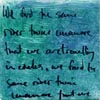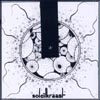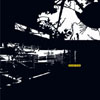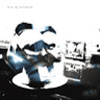 The synthetic compositions of this Canadian-native are more structuredand musical than anything else and thus they stand out and away fromthe other June releases on Drone Records. An orchestral string sectionof synthesizers sway back and forth like a boat at sea as "Same RiverTwice" begins and slowly any distinction between boat and sea is erodedby the duration of the sounds. Crystalline bird calls and full,indefinite tones begin to coalesce with each other and somehow providethe illusion of guitar strings being plucked. The pelagic corpus ofmusic slowly melds into each other until no distinction can be madewhatsoever between the music that began this song and the elements thatwere added slowly. If "Same River Twice" is akin to a swelling mass ofmemories, ideas, and emotions, then "Some Of My Best Friends Are 3/4Water" is akin to an ancient mystical dance that might've been playedout in 13th or 14th century Arabia. A flute plays an intricate helix ofnotes that slide and swirl like smoke throughout the air and thewhistle of rough materials gliding against each other reverberateagainst immaculate palace walls. Some manner of seductive dance playsitself out on a showroom floor and quietly, like a building storm, astrain becomes evident on the faces of all the spectators and surge ofenergy pours forth and finds itself expressed in the rhythmic beatingof bells and hammered instruments. The slow pace and absolutely sexualnature of this piece is addictive and I'm sure I could wear out thevinyl listening to this song over and over again. The way that thestringed instruments shimmer and meditate with the flute and the atonalplucking of strings produces a trance-like effect that borders on thehypnotic. Though the theme of water seemed obvious to me on the firstside, on the second it seems as though the desert is at heart ofeverything. I can easily imagine an individual galloping across thedesert on a horse in a desperate attempt to outrun a coming sandstorm.All the decadence and colors of affluent kings with their spices andflourishing trade routes haunt the instruments and arrangement of sidetwo. Aidan Baker has released quite a few records through otherchannels, but this could easily serve as a great introduction to hiswork. Both sides are addictive pieces of strange music that obtain akind of sensuous quality few others even bother trying to reach for.
The synthetic compositions of this Canadian-native are more structuredand musical than anything else and thus they stand out and away fromthe other June releases on Drone Records. An orchestral string sectionof synthesizers sway back and forth like a boat at sea as "Same RiverTwice" begins and slowly any distinction between boat and sea is erodedby the duration of the sounds. Crystalline bird calls and full,indefinite tones begin to coalesce with each other and somehow providethe illusion of guitar strings being plucked. The pelagic corpus ofmusic slowly melds into each other until no distinction can be madewhatsoever between the music that began this song and the elements thatwere added slowly. If "Same River Twice" is akin to a swelling mass ofmemories, ideas, and emotions, then "Some Of My Best Friends Are 3/4Water" is akin to an ancient mystical dance that might've been playedout in 13th or 14th century Arabia. A flute plays an intricate helix ofnotes that slide and swirl like smoke throughout the air and thewhistle of rough materials gliding against each other reverberateagainst immaculate palace walls. Some manner of seductive dance playsitself out on a showroom floor and quietly, like a building storm, astrain becomes evident on the faces of all the spectators and surge ofenergy pours forth and finds itself expressed in the rhythmic beatingof bells and hammered instruments. The slow pace and absolutely sexualnature of this piece is addictive and I'm sure I could wear out thevinyl listening to this song over and over again. The way that thestringed instruments shimmer and meditate with the flute and the atonalplucking of strings produces a trance-like effect that borders on thehypnotic. Though the theme of water seemed obvious to me on the firstside, on the second it seems as though the desert is at heart ofeverything. I can easily imagine an individual galloping across thedesert on a horse in a desperate attempt to outrun a coming sandstorm.All the decadence and colors of affluent kings with their spices andflourishing trade routes haunt the instruments and arrangement of sidetwo. Aidan Baker has released quite a few records through otherchannels, but this could easily serve as a great introduction to hiswork. Both sides are addictive pieces of strange music that obtain akind of sensuous quality few others even bother trying to reach for.
Two new shows just for you. We have squeezed out two extended release episodes for this weekend to get you through this week. They contain mostly new songs but there's also new issues from the vaults. The first show features music from Rider/Horse, Mint Field, Robert Aiki Aubrey Lowe, Anastasia Coope, ISAN, Stone Music, La Securite, Bark Psychosis, Jon Rose, Master Wilburn Burchette, Umberto, Wand, Tim Koh, Sun An, and Memory Drawings. The second episode has music by Laibach, Melt-Banana, Chuck Johnson, X, K. Yoshimatsu, Dorothy Carter, Pavel Milyakov, Violence Gratuite, Mark Templeton, Dummy, Endon, body / negative, Midwife, Alberto Boccardi, Divine. Cow in Maui from Veronika in Vienna. Get involved: subscribe, review, rate, share with your friends, send images! |



 This German duo must have some understanding of what it means to beuniversal. Their sounds are of sources that are completely unknown tome (though I can describe their qualities) and yet they can evoke asense of comfort and complete familiarity. The way that "Mletkin"begins, I was sure that I was going to face more of the faceless. Thesounds on both of these songs begin darkly, as though the demonic andevil were central to Herbst9's music. As the sounds progress, however,light and simple keyboards play steady one and two note melodies thatfade and drift between eachother. Harmonies begin to phase into thebody of found sounds, sacred melodies, and quiet rattles and soonafter, it's difficult to imagine anything even remotely dangerous orunbearable. Enenylynis a beautiful mixture of the seen and the unseen, the light and thedark, or the mundane and the sacred. "Mletkin" begins as an uneasywhirl through a long and empty shaft; only medical light illuminatesthe walls here and what waits at the end of this drop is black andgrievous. A strange trembling sound fills this shaft until, at last,the fall ends and it empties into a perfect space filled only with themost healing of light. The frog sounds and cosmic rushes of sound allmesh together with the aquatic rumble of enormous caverns and starlightmoans. The movement of the entire song is one of life and death."Mletkin" begins as an undefined mass and, in its attempt to finditself, opens a wound that spills out the most wonderful music. Allthis only to fade away into the undefined again. "Tynemlem" continuesby picking up the aquatic sounds from side one and translating theminto a slightly less dense piece of music. Again, it seems as thoughtHerbst9 likes to move between concepts, never allowing a sense of fearto linger for too long, and never letting the aura of life in thekeyboards stand alone. As a strange mud or thick liquid boils in acauldron, a slow steam builds in pipes layered just beneath the groundand pebbles roll about on the floor through the volition of their ownwill. Just as new and recognizable sounds begin to breathe themselvesto life, a faint and strongly emotional melody begins to cycle in thebackground, growing louder with each repetition. A river of natural andsynthetic roars, groans, and hushes sketch themselves over this melodyuntil the piece collapses over the edge of a waterfall in a sudden andexplosive death. Once again I find this isn't enough: I'm wishing thatthese fifteen minutes could be expanded into a full fourty or fifty.
This German duo must have some understanding of what it means to beuniversal. Their sounds are of sources that are completely unknown tome (though I can describe their qualities) and yet they can evoke asense of comfort and complete familiarity. The way that "Mletkin"begins, I was sure that I was going to face more of the faceless. Thesounds on both of these songs begin darkly, as though the demonic andevil were central to Herbst9's music. As the sounds progress, however,light and simple keyboards play steady one and two note melodies thatfade and drift between eachother. Harmonies begin to phase into thebody of found sounds, sacred melodies, and quiet rattles and soonafter, it's difficult to imagine anything even remotely dangerous orunbearable. Enenylynis a beautiful mixture of the seen and the unseen, the light and thedark, or the mundane and the sacred. "Mletkin" begins as an uneasywhirl through a long and empty shaft; only medical light illuminatesthe walls here and what waits at the end of this drop is black andgrievous. A strange trembling sound fills this shaft until, at last,the fall ends and it empties into a perfect space filled only with themost healing of light. The frog sounds and cosmic rushes of sound allmesh together with the aquatic rumble of enormous caverns and starlightmoans. The movement of the entire song is one of life and death."Mletkin" begins as an undefined mass and, in its attempt to finditself, opens a wound that spills out the most wonderful music. Allthis only to fade away into the undefined again. "Tynemlem" continuesby picking up the aquatic sounds from side one and translating theminto a slightly less dense piece of music. Again, it seems as thoughtHerbst9 likes to move between concepts, never allowing a sense of fearto linger for too long, and never letting the aura of life in thekeyboards stand alone. As a strange mud or thick liquid boils in acauldron, a slow steam builds in pipes layered just beneath the groundand pebbles roll about on the floor through the volition of their ownwill. Just as new and recognizable sounds begin to breathe themselvesto life, a faint and strongly emotional melody begins to cycle in thebackground, growing louder with each repetition. A river of natural andsynthetic roars, groans, and hushes sketch themselves over this melodyuntil the piece collapses over the edge of a waterfall in a sudden andexplosive death. Once again I find this isn't enough: I'm wishing thatthese fifteen minutes could be expanded into a full fourty or fifty.  Cold northern nights ring through the open air in the form of ferocious roars and distorted whines on this 7" from the heart of Russia. Insanely packaged in the warmth of a two-inch thick, hand-sewn, wool cover and numbered by the duo, the music on VS is sickeningly intense and nauseatingly careful. A full onslaught of boisterous misery might have a frightful effect on some, but Cisfinitum opt to stir fear by mixing near-familiar elements into something completely unfamiliar.
Cold northern nights ring through the open air in the form of ferocious roars and distorted whines on this 7" from the heart of Russia. Insanely packaged in the warmth of a two-inch thick, hand-sewn, wool cover and numbered by the duo, the music on VS is sickeningly intense and nauseatingly careful. A full onslaught of boisterous misery might have a frightful effect on some, but Cisfinitum opt to stir fear by mixing near-familiar elements into something completely unfamiliar. Two pieces of vastly different music occupy this 7" and the sheer gracethat they are handled with evidence a superior composer behind it all.The first side is full of escalating violence and phased aggressionechoing up and through a bottomless pit filled with something toodesperate to even name. Its slime worms its way up through dirt andhidden, underground passages until it finally surges to the top andexplodes in a glorious and suicidal display of sound and fury. Thesecond side is a consideration of the night and its chilling aura. Apiano rolls delicately about the air while a moonlit mountain exhibitssome strange behavior in the distance. The trees blow slowly, soundssnap and wheeze in the distance, and time begins to slow down. Thesetwo tracks couldn't be much different. Solielkraast is evidently aone-man project from out of Nantes, France. The noise and abrasiveelements of "Zoyd Kraast" come as a complete contrast to the frailty,delicacy, and intricacy of "Eesdaia." While many beatless orsound-collage records might maintain a constant tone so as to establisha mood and use it to its full potential, Solielkraast reaches foropposite poles and ends up getting a firm hold on both of them. Notonly are two excellent extremes presented on this release, but both arecalculated and arranged to near perfection. The trembling and robustpiano playing on "Eesdaia" is pure fear and dread come to life and itsconsiderate role in this song makes it one of the most extraordinarypieces of strange music I've heard this year. It isn't just the musicthat is spectacular, however. The vinyl itself is orange with yellowdustings and it comes inside a handmade cover by Solielkraast. Thisrelease has provided as much as a 7" can, but I'm aching for more thanjust these 17 minutes.
Two pieces of vastly different music occupy this 7" and the sheer gracethat they are handled with evidence a superior composer behind it all.The first side is full of escalating violence and phased aggressionechoing up and through a bottomless pit filled with something toodesperate to even name. Its slime worms its way up through dirt andhidden, underground passages until it finally surges to the top andexplodes in a glorious and suicidal display of sound and fury. Thesecond side is a consideration of the night and its chilling aura. Apiano rolls delicately about the air while a moonlit mountain exhibitssome strange behavior in the distance. The trees blow slowly, soundssnap and wheeze in the distance, and time begins to slow down. Thesetwo tracks couldn't be much different. Solielkraast is evidently aone-man project from out of Nantes, France. The noise and abrasiveelements of "Zoyd Kraast" come as a complete contrast to the frailty,delicacy, and intricacy of "Eesdaia." While many beatless orsound-collage records might maintain a constant tone so as to establisha mood and use it to its full potential, Solielkraast reaches foropposite poles and ends up getting a firm hold on both of them. Notonly are two excellent extremes presented on this release, but both arecalculated and arranged to near perfection. The trembling and robustpiano playing on "Eesdaia" is pure fear and dread come to life and itsconsiderate role in this song makes it one of the most extraordinarypieces of strange music I've heard this year. It isn't just the musicthat is spectacular, however. The vinyl itself is orange with yellowdustings and it comes inside a handmade cover by Solielkraast. Thisrelease has provided as much as a 7" can, but I'm aching for more thanjust these 17 minutes. Tribute albums fall into different categories. There's the serious, professionally assembled tribute albums with a cast of well-known well-respected players on a firmly established or hip record label (see Blue Skied an' Clear and A Tribute to Spacemen 3); there's the abominable releases where a cast of has-beens and never-have-beens are found together unbeknownst in some cash-in-quick scheme (see the entire Cleopatra catalogue); there's the fanboy ones where a group of friends just decide to do something for kicks and trade it amongst themselves (see nearly any email list); then there's the painful, uninspiring ones which are posing as a professional tribute but wind up with more bad contributions than good ones (see For the Masses and A Means to and End). We Could Live In Hope isn't simply a Low tribute, it's a song-by-song cover of Low's very first full-length album (with two versions of "Words.") With a cast of people like Red House Painters' Marc Kozelek, His Name is Alive with Dan and Liz from Ida, A Northern Chorus, and Jessica Bailiff, the disc seems promising, but it's got some harsh problematic recordings which hold it back.
Tribute albums fall into different categories. There's the serious, professionally assembled tribute albums with a cast of well-known well-respected players on a firmly established or hip record label (see Blue Skied an' Clear and A Tribute to Spacemen 3); there's the abominable releases where a cast of has-beens and never-have-beens are found together unbeknownst in some cash-in-quick scheme (see the entire Cleopatra catalogue); there's the fanboy ones where a group of friends just decide to do something for kicks and trade it amongst themselves (see nearly any email list); then there's the painful, uninspiring ones which are posing as a professional tribute but wind up with more bad contributions than good ones (see For the Masses and A Means to and End). We Could Live In Hope isn't simply a Low tribute, it's a song-by-song cover of Low's very first full-length album (with two versions of "Words.") With a cast of people like Red House Painters' Marc Kozelek, His Name is Alive with Dan and Liz from Ida, A Northern Chorus, and Jessica Bailiff, the disc seems promising, but it's got some harsh problematic recordings which hold it back. Delivery Room is a bargain-priced sampler of new and upcoming releases from the Leaf Label, and reflects the eclectic, modern aesthetic of label boss Tony Morley. Unfortunately, as is often the case with collections such as these, there is a fair amount of substandard material by bands the label hopes to promote, as well as songs that suffer from the lack of context inherent in a compilation.
Delivery Room is a bargain-priced sampler of new and upcoming releases from the Leaf Label, and reflects the eclectic, modern aesthetic of label boss Tony Morley. Unfortunately, as is often the case with collections such as these, there is a fair amount of substandard material by bands the label hopes to promote, as well as songs that suffer from the lack of context inherent in a compilation. The melodies might be vibrant and the arrangements lush, but nothingcan fix the feeling that there's a lot of counterfeit sentiment beingtossed around this album. I'd like to say I felt something whilelistening to this record, but the vocal delivery and the sappy,over-romantic instrumentation simply sounded too much like a bad radiodrama to be interesting. Fakeopens up with the seven minute creeper, "Born." The vocalist soundslike he is trying hard to say something that is emotionally drainingand utterly important, but he comes across sounding like a 10 year oldboy convinced that he's in love. Speaking of 10 year old boys, thelyrics sound as though they're meant to convey all sorts of meanings(it's the delivery of the singer that makes them sound so important)but I'm not sure I understand what he's singing about on "Born." I'mnot sure I know what's going on in any of these ten songs to tell thetruth. Blow Up Hollywood are obviously reaching for some lofty conceptthat will lift them up above other bands and into the realms of"important" and "socially conscious;" one look at their website and itseems like they've got this grand Zen-influenced statement to make.This teenager-symptom (self-importance?) ruins what talent the bandhas. That self-importance isn't just in the singer's head, though,otherwise I might have been able to enjoy the album for its music. Themusic sounds like a half-assed attempt at mixing the grandeur oforchestral music with the glossy sheen of popular rock n' roll radio.There's absolutely no grit anywhere on the record, that's what makes it sound so damned self-important and phony.There's absolutely no sign of anger, no sign of confusion, or any hintthat maybe pain could take part in these sappy meanderings. That slickand prosthetic production accounts for 90% of what's wrong with themusic. There might be room for this somewhere in a bad movie where theboy finds the girl and they fall in love all over again despite thefact that, while she was away, he was busy with about 10 other girls.Right, suddenly jackass is in love and everything's going to be okayand in the end there's going to be a white picket fence, little cryingbastards everywhere, and a dog attacking the mailman in the front yard.Forgive me for being so angry, but when a mediocre album entitled Fakecrosses my path and then tries to play itself off as ananti-establishment or somehow spiritually fulfilling record thateschews all pretense, I tend towards a complete lack of faith in thehonestly rebellious spirit and begin to think that maybe the last 10years of federally sponsored media mergers has completely killed anyreal chance of music inspiring righteous indignation and civildisobedience ever again.-
The melodies might be vibrant and the arrangements lush, but nothingcan fix the feeling that there's a lot of counterfeit sentiment beingtossed around this album. I'd like to say I felt something whilelistening to this record, but the vocal delivery and the sappy,over-romantic instrumentation simply sounded too much like a bad radiodrama to be interesting. Fakeopens up with the seven minute creeper, "Born." The vocalist soundslike he is trying hard to say something that is emotionally drainingand utterly important, but he comes across sounding like a 10 year oldboy convinced that he's in love. Speaking of 10 year old boys, thelyrics sound as though they're meant to convey all sorts of meanings(it's the delivery of the singer that makes them sound so important)but I'm not sure I understand what he's singing about on "Born." I'mnot sure I know what's going on in any of these ten songs to tell thetruth. Blow Up Hollywood are obviously reaching for some lofty conceptthat will lift them up above other bands and into the realms of"important" and "socially conscious;" one look at their website and itseems like they've got this grand Zen-influenced statement to make.This teenager-symptom (self-importance?) ruins what talent the bandhas. That self-importance isn't just in the singer's head, though,otherwise I might have been able to enjoy the album for its music. Themusic sounds like a half-assed attempt at mixing the grandeur oforchestral music with the glossy sheen of popular rock n' roll radio.There's absolutely no grit anywhere on the record, that's what makes it sound so damned self-important and phony.There's absolutely no sign of anger, no sign of confusion, or any hintthat maybe pain could take part in these sappy meanderings. That slickand prosthetic production accounts for 90% of what's wrong with themusic. There might be room for this somewhere in a bad movie where theboy finds the girl and they fall in love all over again despite thefact that, while she was away, he was busy with about 10 other girls.Right, suddenly jackass is in love and everything's going to be okayand in the end there's going to be a white picket fence, little cryingbastards everywhere, and a dog attacking the mailman in the front yard.Forgive me for being so angry, but when a mediocre album entitled Fakecrosses my path and then tries to play itself off as ananti-establishment or somehow spiritually fulfilling record thateschews all pretense, I tend towards a complete lack of faith in thehonestly rebellious spirit and begin to think that maybe the last 10years of federally sponsored media mergers has completely killed anyreal chance of music inspiring righteous indignation and civildisobedience ever again.- 
